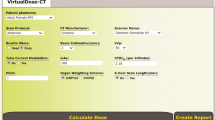Abstract
The European Union’s SOLO (Epidemiological Studies of Exposed Southern Urals Populations) project aims to improve understanding of cancer risks associated with chronic in utero radiation exposure. A comprehensive series of hybrid computational fetal phantoms was previously developed at the University of Florida in order to provide the SOLO project with the capability of computationally simulating and quantifying radiation exposures to individual fetal bones and soft tissue organs. To improve harmonization between the SOLO fetal biokinetic models and the computational phantoms, a subset of those phantoms was systematically modified to create a novel series of phantoms matching anatomical data representing Russian fetal biometry in the Southern Urals. Using previously established modeling techniques, eight computational Urals-based phantoms aged 8, 12, 18, 22, 26, 30, 34, and 38 weeks post-conception were constructed to match appropriate age-dependent femur lengths, biparietal diameters, individual bone masses and whole-body masses. Bone and soft tissue organ mass differences between the common ages of the subset of UF phantom series and the Urals-based phantom series illustrated the need for improved understanding of fetal bone densities as a critical parameter of computational phantom development. In anticipation for SOLO radiation dosimetry studies involving the developing fetus and pregnant female, the completed phantom series was successfully converted to a cuboidal voxel format easily interpreted by radiation transport software.


Similar content being viewed by others
References
Blinov AY (2003) The significance of ultrasound measurement of fetal femur length in prenatal diagnostics of Down’s syndrome. Cheylabinsk State Medical Academy, Cheylabinsk
Bolch WE, Eckerman KF, Sgouros G, Thomas SR (2009) MIRD Pamphlet No. 21: a generalized schema for radiopharmaceutical dosimetry: standardization of nomenclature. J Nucl Med 50:477–484
Borisov BK (1967) Weight indexes of human fetus development and strontium and calcium abundance in the skeleton. Report INIS-mf-113 1-14
Degteva MO, Shagina NB, Vorobiova MI, Anspaugh LR, Napier BA (2012) Re-evaluation of waterborne releases of radioactive materials from the Mayak Production Association into the Techa River in 1949–1951. Health Phys 102:25–38
Fell TP, Harrison JD, Leggett RW (2001) A model for the transfer of alkaline earth elements to the fetus. Radiat Prot Dosim 95:309–321
ICRP (1995) ICRP Publication 70: basic anatomical and physiological data for use in radiological protection: the skeleton. Ann ICRP 25:1–180
Kim CH, Jeong JH, Bolch WE, Cho KW, Hwang SB (2011) A polygon-surface reference Korean male phantom (PSRK-Man) and its direct implementation in Geant4 Monte Carlo simulation. Phys Med Biol 56:3137–3161
Kossenko MM, Ostroumova E, Granath F, Hall P (2002) Studies on the Techa river offspring cohort: health effects. Radiat Environ Biophys 41:49–52
Kurmanavicius J, Wright EM, Royston P, Zimmermann R, Huch R, Huch A, Wisser J (1999) Fetal ultrasound biometry: 2. Abdomen and femur length reference values. Br J Obstet Gynaecol 106:136–143
Lazarus E, Debenedectis C, North D, Spencer PK, Mayo-Smith WW (2009) Utilization of imaging in pregnant patients: 10-year review of 5270 examinations in 3285 patients—1997–2006. Radiology 251:517–524
Lee C, Lodwick D, Hasenauer D, Williams JL, Lee C, Bolch WE (2007) Hybrid computational phantoms of the male and female newborn patient: NURBS-based whole-body models. Phys Med Biol 52:3309–3333
Maynard MR, Geyer JW, Aris JP, Shifrin RY, Bolch WE (2011) The UF family of hybrid phantoms of the developing human fetus for computational radiation dosimetry. Phys Med Biol 56:4839–4879
Maynard MR, Shagina NB, Tolstykh EI, Degteva MO, Fell TP, Bolch WE (2014) Fetal organ dosimetry for the Techa River and Ozyorsk Offspring Cohorts: Part 2. Radionuclide S values for fetal self-dose and maternal cross-dose. Radiat Environ Biophys. doi:10.1007/s00411-014-0570-5
Medvedev MV (2002) Ultrasound fetometry: reference tables and nomograms. Realnoe Vremya Publications, Moscow
NCRP (2009) NCRP Report No. 160: ionizing radiation exposure of the population of the United States. National Council on Radiation Protection and Measurement, Bethesda
NCRP (2013) NCRP Report No. 174: preconception and prenatal radiation exposure: health effects and protective guidance. National Council on Radiation Protection and Measurement, Besthesda
Preston DL, Cullings H, Suyama A, Funamoto S, Nishi N, Soda M, Mabuchi K, Kodama K, Kasagi F, Shore RE (2008) Solid cancer incidence in atomic bomb survivors exposed in utero or as young children. J Natl Cancer Inst 100:428–436
Schonfeld SJ, Tsareva YV, Preston DL, Okatenko PV, Gilbert ES, Ron E, Sokolnikov ME, Koshurnikova NA (2012) Cancer mortality following in utero exposure among offspring of female Mayak worker cohort members. Radiat Res 178:160–165
Seeds JW (1996) The routine or screening obstetrical ultrasound examination. Clin Obstet Gynecol 39:814–830
Shagina NB, Tolstykh EI, Fell TP, Harrison JD, Phipps AW, Degteva MO (2007) In utero and postnatal haemopoictic tissue doses resulting from maternal ingestion of strontium isotopes from the Techa river. Radiat Prot Dosim 127:497–501
Acknowledgments
This work was supported in part by Grants FI6R-516478 (SOUL project) and FP7-249675 (SOLO project) from the European Union with the University of Florida.
Author information
Authors and Affiliations
Corresponding author
Rights and permissions
About this article
Cite this article
Maynard, M.R., Shagina, N.B., Tolstykh, E.I. et al. Fetal organ dosimetry for the Techa River and Ozyorsk offspring cohorts, part 1: a Urals-based series of fetal computational phantoms. Radiat Environ Biophys 54, 37–46 (2015). https://doi.org/10.1007/s00411-014-0571-4
Received:
Accepted:
Published:
Issue Date:
DOI: https://doi.org/10.1007/s00411-014-0571-4




